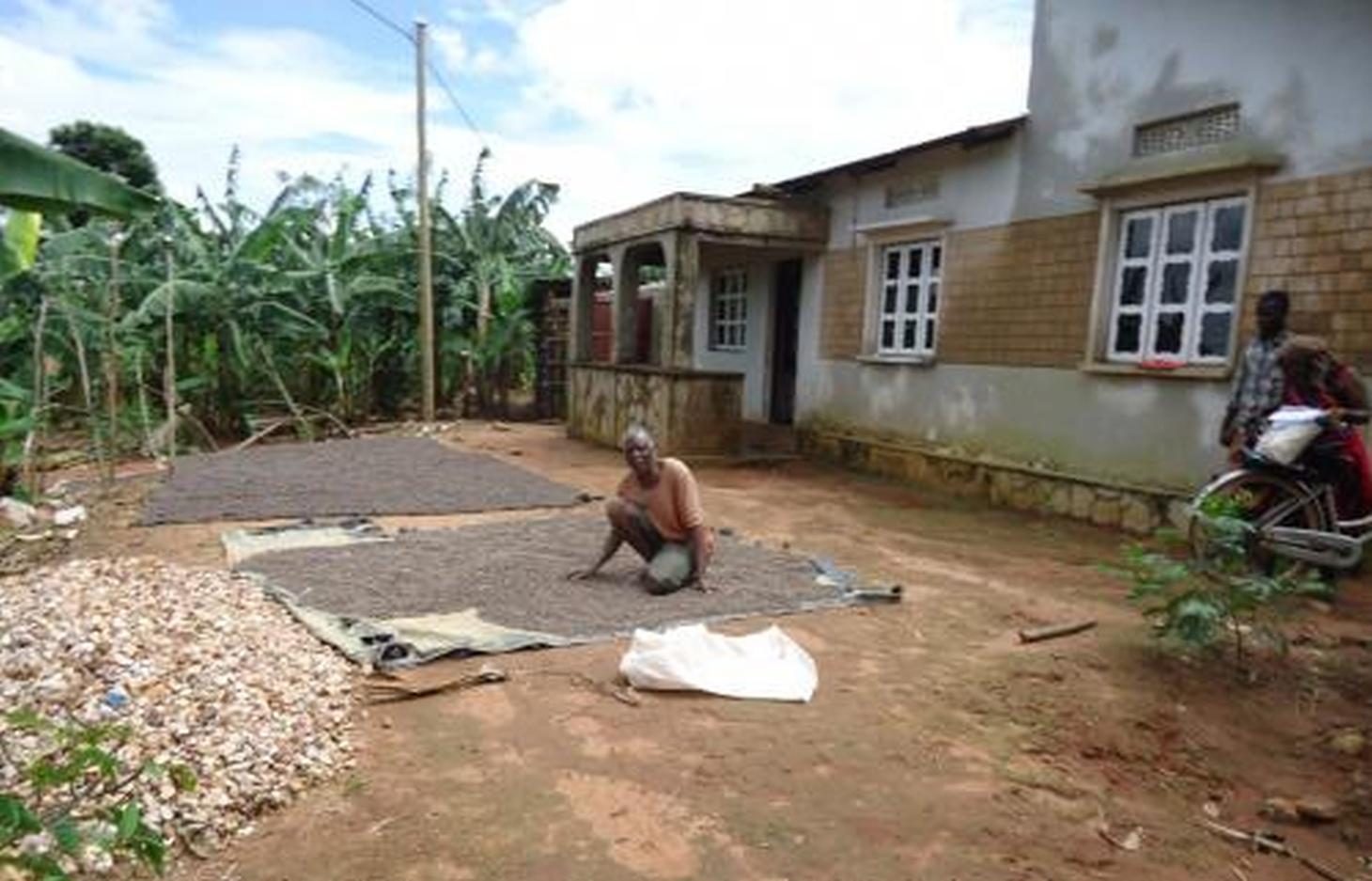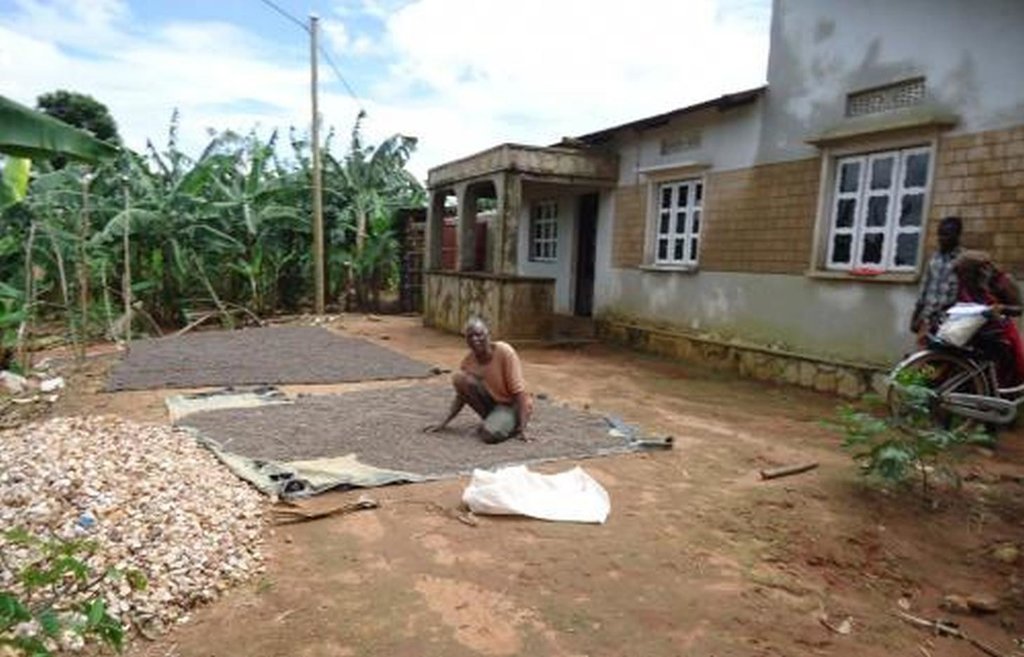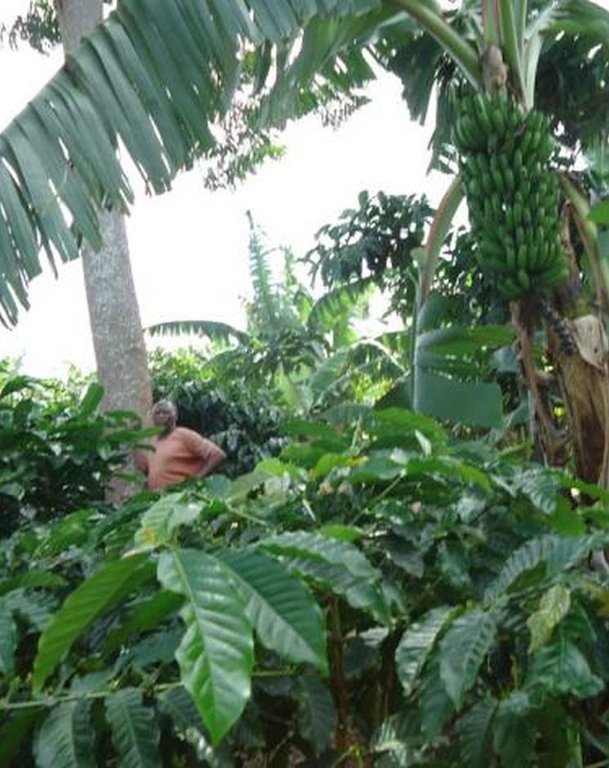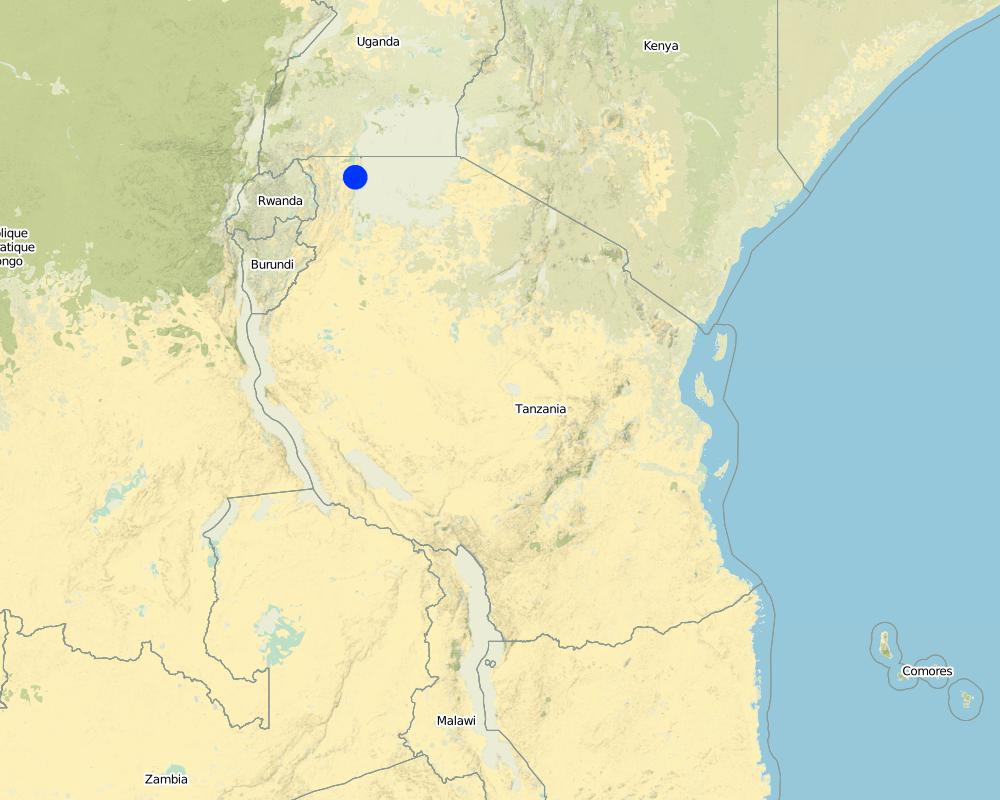Buhaya agroforestry system [坦桑尼亚联合共和国]
- 创建:
- 更新:
- 编制者: Godfrey Baraba
- 编辑者: –
- 审查者: David Streiff, Alexandra Gavilano
Ekibanja (Kihaya)
technologies_1177 - 坦桑尼亚联合共和国
查看章节
全部展开 全部收起1. 一般信息
1.2 参与该技术评估和文件编制的资源人员和机构的联系方式
SLM专业人员:
Government :
Government :
Mashauri Babylus
Bukoba DC
坦桑尼亚联合共和国
Government :
Rutatatinisibwa Dominick
Bukoba DC
坦桑尼亚联合共和国
Government :
Rwezaula Raphael
Bukoba DC
坦桑尼亚联合共和国
SLM专业人员:
Kaihura Fidelis
K-TAMP
坦桑尼亚联合共和国
土地使用者:
Shaaban Habibu
Kyema village farmer
坦桑尼亚联合共和国
有助于对技术进行记录/评估的项目名称(如相关)
The Transboundary Agro-ecosystem Management Project for the Kagera River Basin (GEF-FAO / Kagera TAMP )有助于对技术进行记录/评估的机构名称(如相关)
FAO Food and Agriculture Organization (FAO Food and Agriculture Organization) - 意大利有助于对技术进行记录/评估的机构名称(如相关)
Bukoba district council (Bukoba district council) - 坦桑尼亚联合共和国1.3 关于使用通过WOCAT记录的数据的条件
编制者和关键资源人员接受有关使用通过WOCAT记录数据的条件。:
是
1.5 参考关于SLM方法(使用WOCAT记录的SLM方法)的调查问卷
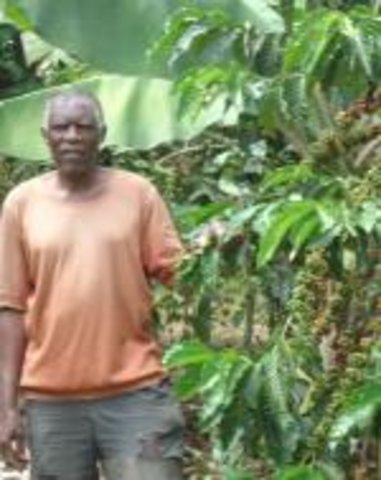
Indigenous knowledge transfer [坦桑尼亚联合共和国]
Indigenous knowledge transfer, is a common phenomena in farming societies whereby elders taught younger generations the practical aspects in production and emphasizes the norms and proms in folk story tales.
- 编制者: Godfrey Baraba
2. SLM技术的说明
2.1 技术简介
技术定义:
Traditional agroforestry system comprising mixture of banana, coffee, fruit trees, biannual crops, annual crops and timber trees which together optimize the use of soil, moisture and space.
2.2 技术的详细说明
说明:
Buhaya agro forest system is a mix of annual and perennial crops together with trees and shrubs are densely planted on a restricted area usually 0.5 -2ha per household to increase crop yield, wood production and conserve soil and water. Buhaya agro forest system is applied on individual owned land specific at home steady. In this technology a plot of 1ha comprises of :
1.Perennial crops (coffee, banana, ) on average (10,000/36 coffee plants can be planted in one hector randomly in the alternating manner with banana, 10,000/25 banana stools) can be planted in 1ha randomly in the alternating manner with coffee.
2.Annual and biannual crops (eg. Maize, beans, cassava, sweet potatoes, yams etc) are planted in the between spaces. Maize and beans are planted twice in the short (Masika) and long rains (Vuli) where tubers are planted at any time throughout the year.
3.Trees and shrubs (eg. Makkhamia spps, Maesopsis and migorora). Trees are planted along the boundaries spaced at an average of 15m to act as wind break and timber production. Shrubs are planted at closed distance in between trees to act as live fence.
Buhaya agro forest system was practiced since early 1900. Application of farmyard manures and crop residue mulch are the supportive measures. The land owners keep small livestock/ few cattle under zero grazing to obtain manure for soil fertility improvem
Purpose of the Technology: The purposes for applying the technology is to control soil erosion and nutrient improvement.
Establishment / maintenance activities and inputs: The establishment of Buhaya agro forest system is done on a virgin land starting in the dry season July to September and it normally takes 2-5years by doing the following activities.
1.To prepare the land by cutting, removing/burning shrubs and grasses followed by land tillage. This is the difficult job and sometimes it can force the farmer to plant annual crops before planting perennial crops due to inadequate preparation time.
2.To dig holes of different size according to what crop is meant for in the alternating manner. This activity is done after harvesting annual crops in shot rainfalls (March to June).
3.To plant banana in July and August followed by coffee in September to November and March to May next year.
4.To plant trees along the boundaries followed by planting shrubs between the trees spacing to create a live fence.
5.To plant cassava, yams, pawpaw, avocados and mangoes. These are planted randomly and in a few quantity.
The maintenance of Buhaya agro forest system is the simple but tidies job requires all the year to be working in the garden. The required activities are
1.To weed the field as preparation for planting seasonal crops( i.e maize and beans) twice per year in dry seasons.
2.To remove unwanted banana suckers (desuckering) and harvested banana stems in order to maintain a required number of plants( mother, daughter and grand daughter) per stool. This requires a lot of time for assessing the plant health as well as spacing.
3.To plant and harvest maize and beans twice per year.
4.To prune coffee trees, harvest coffee cherry, dry, and market them once per year.
5.To replace harvested cassava and yams as required.
2.3 技术照片
2.5 已应用该技术的、本评估所涵盖的国家/地区/地点
国家:
坦桑尼亚联合共和国
区域/州/省:
Tanzania
有关地点的进一步说明:
Bukoba District (Kyema village)
具体说明该技术的分布:
- 均匀地分布在一个区域
如果不知道精确的区域,请注明大致覆盖的区域:
- 1-10 平方千米
Map
×2.6 实施日期
如果不知道确切的年份,请说明大概的日期:
- 50多年前(传统)
2.7 技术介绍
详细说明该技术是如何引入的:
- 作为传统系统的一部分(> 50 年)
注释(项目类型等):
It is said that in 1939 after second world war there was a hunger in Bukoba which forced people to plant banana instead of the traditional cropping of sorghum and millet. During the British colonial people were forced to cultivate coffee; as well health services introduced by Christian missionaries increased the population growth which revealed pressure on land and forced to opt agro forest.
3. SLM技术的分类
3.1 该技术的主要目的
- 结合其他技术保护流域/下游区域
3.2 应用该技术的当前土地利用类型
同一土地单元内混合使用的土地::
是
具体说明混合土地使用(作物/放牧/树木):
- 农林业

农田
- 一年一作
- 多年一作(非木材)
- 乔木与灌木的种植
年作 - 具体指明作物:
- 谷物类 - 玉米
- 豆科牧草和豆类 - 豆子
- 根/块茎作物 - 红薯、山药、芋头/椰子,其他
多年生(非木质)作物 - 指定作物:
- 香蕉/芭蕉/蕉麻
乔木和灌木种植 - 指定作物:
- 咖啡,露天种植
- 水果、其他
- Makkhamia spps, Maesopsis and Migorora
每年的生长季节数:
- 2
具体说明:
Longest growing period in days: 120; Longest growing period from month to month: September to December; Second longest growing period in days: 65; Second longest growing period from month to month: March to May

牧场
动物类型:
- 牛 - 非乳制品工作
注释:
Major land use problems (compiler’s opinion): The major land use problem was soil erosion and excessive nutrient mining
Major land use problems (land users’ perception): Limited suitable land for cropping in the area
Future (final) land use (after implementation of SLM Technology): Mixed: Mf: Agroforestry
3.4 供水
该技术所应用土地的供水:
- 雨养
3.5 该技术所属的SLM组
- 农业林学
3.6 包含该技术的可持续土地管理措施

农艺措施
- A1:植被和土壤覆盖层

植物措施
- V1:乔木和灌木覆盖层
- V2:草和多年生草本植物

管理措施
- M1:改变土地使用类型
注释:
Secondary measures: agronomic measures
Type of vegetative measures: scattered / dispersed
3.7 该技术强调的主要土地退化类型

土壤水蚀
- Wt:表土流失/地表侵蚀

化学性土壤退化
- Cn:肥力下降和有机质含量下降(非侵蚀所致)
注释:
Main causes of degradation: soil management (cultivation along the slopes versus across the slopes.), crop management (annual, perennial, tree/shrub) (Routeenly harvests without fertilization implies permanent removal of nutriets.), Heavy / extreme rainfall (intensity/amounts) (average rainfall 1,200mm on slopes), other natural causes (avalanches, volcanic eruptions, mud flows, highly susceptible natural resources, extreme topography, etc.) specify (Sandstone parent material), education, access to knowledge and support services (Inadequate extension services)
Secondary causes of degradation: poverty / wealth (Limited household income to invest in sustainable land management), labour availability (Labour force dominated by the elderly)
3.8 防止、减少或恢复土地退化
具体数量名该技术与土地退化有关的目标:
- 防止土地退化
- 减少土地退化
注释:
Secondary goals: mitigation / reduction of land degradation
4. 技术规范、实施活动、投入和成本
4.1 该技术的技术图纸
技术规范(与技术图纸相关):
Overview of the Buhaya agroforestry system. Average of 5m spacing between banana plants then alternate with coffee after two stools. Cassava and yams scattered at the space after 6 to 10 stools. beans and maize are planted in the left space to make sure all soil surface is covered. Long trees (Maesopsis spps) spaced at 10m.
Location: Kyema village. Bukoba/Kagera/Tanzania
Date: 22 MAY 2012
Technical knowledge required for field staff / advisors: moderate (The importance of diversification for income stabilization.)
Technical knowledge required for land users: moderate (Trees can improve income generating and assure food security in the sense of food accessibility.)
Main technical functions: improvement of ground cover, increase in organic matter, increase in nutrient availability (supply, recycling,…)
Secondary technical functions: control of raindrop splash, control of dispersed runoff: retain / trap, stabilisation of soil (eg by tree roots against land slides), increase of infiltration, increase / maintain water stored in soil, reduction in wind speed
Scattered / dispersed
Vegetative material: T : trees / shrubs, F : fruit trees / shrubs, C : perennial crops, O : other
Trees/ shrubs species: Makhamia spp, Maesopsis eminii are planted
Fruit trees / shrubs species: Mangifera indica, Carica papaya, Persia americana are planted
Perennial crops species: Musa spp are planted
Change of land use type: Change from cropland (Annual and biannual crop production eg. millet, sorghum and beans) to Aggro forest.
作者:
Godfrey Baraba, BOX 491, BUKOBA
4.2 有关投入和成本计算的一般信息
具体说明成本计算所用货币:
- 美元
注明雇用劳工的每日平均工资成本:
1.60
4.3 技术建立活动
| 活动 | 时间(季度) | |
|---|---|---|
| 1. | Land preparation | July to August |
| 2. | Digging holes | Jan & Jul |
| 3. | Planting banana and coffee | Jul to Sep |
| 4. | Planting trees and shrubs | Feb & Sep |
| 5. | Planting biannual crops | March, Apr, Oct, Nov &Dec |
4.4 技术建立所需要的费用和投入
| 对投入进行具体说明 | 单位 | 数量 | 单位成本 | 每项投入的总成本 | 土地使用者承担的成本% | |
|---|---|---|---|---|---|---|
| 劳动力 | Land preparation | persons/day/ha | 333.3 | 1.25 | 416.63 | 100.0 |
| 劳动力 | Digging holes | persons/day/ha | 81.63 | 1.25 | 102.04 | 100.0 |
| 劳动力 | Planting banana and coffee | persons/day/ha | 33.33 | 1.25 | 41.66 | 100.0 |
| 劳动力 | Planting trees, shrubs and biannual crops | persons/day/ha | 158.6 | 1.25 | 198.25 | 100.0 |
| 设备 | Axes | pieces/ha | 5.55 | 3.128 | 17.36 | 100.0 |
| 设备 | Machete | pieces/ha | 5.55 | 1.877 | 10.42 | 100.0 |
| 设备 | Hand hoes | pieces/ha | 5.55 | 3.128 | 17.36 | 100.0 |
| 设备 | Spades | pieces/ha | 2.7 | 3.148 | 8.5 | 100.0 |
| 植物材料 | Banana suckers | pieces/ha | 571.0 | 0.1875 | 107.06 | 100.0 |
| 植物材料 | Coffee seedlings | pieces/ha | 357.0 | 0.3125 | 111.56 | 100.0 |
| 植物材料 | Mysopsis | pieces/ha | 33.0 | 0.125 | 4.13 | 100.0 |
| 植物材料 | Migorora | pieces/ha | 80.0 | 0.125 | 10.0 | 100.0 |
| 植物材料 | Avocado | pieces/ha | 11.0 | 3.167 | 34.84 | 100.0 |
| 植物材料 | Mangoes | pieces/ha | 5.0 | 3.125 | 15.63 | 100.0 |
| 植物材料 | Cassava | pieces/ha | 47.0 | 0.0317 | 1.49 | 100.0 |
| 植物材料 | Yams | pieces/ha | 26.0 | 0.031 | 0.81 | |
| 技术建立所需总成本 | 1097.74 | |||||
| 技术建立总成本,美元 | 1097.74 | |||||
注释:
Duration of establishment phase: 12 month(s)
4.5 维护/经常性活动
| 活动 | 时间/频率 | |
|---|---|---|
| 1. | Weeding | Feb & Sep |
| 2. | Desuckering | Jul to Sept |
| 3. | Planting annual crops | March to Jul & Sep to Dec |
| 4. | Punning, harvesting and drying coffee | May to October |
| 5. | Cassava and yams harvesting. | Jan to Dec |
4.6 维护/经常性活动所需要的费用和投入(每年)
| 对投入进行具体说明 | 单位 | 数量 | 单位成本 | 每项投入的总成本 | 土地使用者承担的成本% | |
|---|---|---|---|---|---|---|
| 劳动力 | Weeding | persons/day/ha | 200.0 | 1.25 | 250.0 | 100.0 |
| 劳动力 | Desuckering | persons/day/ha | 57.0 | 1.25 | 71.25 | 100.0 |
| 劳动力 | Planting annual crops | persons/day/ha | 50.0 | 1.25 | 62.5 | 100.0 |
| 劳动力 | Prunning, harvesting and drying coffee | persons/day/ha | 285.5 | 1.25 | 356.88 | 100.0 |
| 植物材料 | Seeds | pieces/ha | 10.0 | 2.5 | 25.0 | 100.0 |
| 植物材料 | Seedlings | pieces/ha | 26.0 | 0.031 | 0.81 | 100.0 |
| 植物材料 | Cassava | pieces/ha | 48.0 | 0.0317 | 1.52 | 100.0 |
| 植物材料 | Beans | pieces/ha | 20.0 | 1.25 | 25.0 | 100.0 |
| 其它 | Labour: Cassava and yams harvesting | persons/day/ha | 2.3 | 1.25 | 2.88 | 100.0 |
| 技术维护所需总成本 | 795.84 | |||||
| 技术维护总成本,美元 | 795.84 | |||||
注释:
The above cost was calculated as 1manday equivalent to 8 working hours with the following performances; ploughing 30m2, weeding 400m2, land clearing 10m2, de suckering 30 stools, Harvesting and pruning 3 coffee trees.
4.7 影响成本的最重要因素
描述影响成本的最决定性因素:
The most determinate factor affecting the cost is labour. This is because the technology is labour intensive, while labour force is inadequate.
5. 自然和人文环境
5.1 气候
年降雨量
- < 250毫米
- 251-500毫米
- 501-750毫米
- 751-1,000毫米
- 1,001-1,500毫米
- 1,501-2,000毫米
- 2,001-3,000毫米
- 3,001-4,000毫米
- > 4,000毫米
有关降雨的规范/注释:
Bimodal, length of dry period 180dys
农业气候带
- 半湿润
Thermal climate class: tropics
5.2 地形
平均坡度:
- 水平(0-2%)
- 缓降(3-5%)
- 平缓(6-10%)
- 滚坡(11-15%)
- 崎岖(16-30%)
- 陡峭(31-60%)
- 非常陡峭(>60%)
地形:
- 高原/平原
- 山脊
- 山坡
- 山地斜坡
- 麓坡
- 谷底
垂直分布带:
- 0-100 m a.s.l.
- 101-500 m a.s.l.
- 501-1,000 m a.s.l.
- 1,001-1,500 m a.s.l.
- 1,501-2,000 m a.s.l.
- 2,001-2,500 m a.s.l.
- 2,501-3,000 m a.s.l.
- 3,001-4,000 m a.s.l.
- > 4,000 m a.s.l.
说明该技术是否专门应用于:
- 凸形情况
关于地形的注释和进一步规范:
Slopes on average: 12.8%
Altitudinal zone: 1194m.a.s.l. taken by GPS
5.3 土壤
平均土层深度:
- 非常浅(0-20厘米)
- 浅(21-50厘米)
- 中等深度(51-80厘米)
- 深(81-120厘米)
- 非常深(> 120厘米)
土壤质地(表土):
- 粗粒/轻(砂质)
- 中粒(壤土、粉土)
表土有机质:
- 中(1-3%)
如有可能,附上完整的土壤描述或具体说明可用的信息,例如土壤类型、土壤酸碱度、阳离子交换能力、氮、盐度等。:
Soil fertility is medium - low
Soil drainage / infiltration is good - medium
Soil water storage capacity is medium
5.4 水资源可用性和质量
地下水位表:
5-50米
地表水的可用性:
好
水质(未处理):
不良饮用水(需要处理)
关于水质和水量的注释和进一步规范:
Availability of surface water: Permanent water stream in plenty
Water quality (untreated): Tap water not found in the whole village
5.5 生物多样性
物种多样性:
- 中等
关于生物多样性的注释和进一步规范:
Butterflies, earthworm and ants readily available
5.6 应用该技术的土地使用者的特征
生产系统的市场定位:
- 混合(生计/商业)
非农收入:
- 低于全部收入的10%
相对财富水平:
- 贫瘠
- 平均水平
个人或集体:
- 个人/家庭
机械化水平:
- 手工作业
性别:
- 女人
- 男人
说明土地使用者的其他有关特征:
Land users applying the Technology are mainly common / average land users
Difference in the involvement of women and men: Men usually plays part in field establishment while women engaged in maintenance. Children participates in maintenance as well.
Population density: 200-500 persons/km2
Annual population growth: 1% - 2%
5% of the land users are rich and own 30% of the land.
75% of the land users are average wealthy and own 60% of the land.
20% of the land users are poor and own 10% of the land.
Off-farm income specification: The one who did not apply the technology depends on more than 85% of his income from off farm activities.
Market orientation of production system: Coffee is 100% for commecial the rest are for home consumption.
Level of mechanization: Land cultivation only at establishement, then weeding is done by bare hands and planting bu small hand hoes (vihosho)
5.7 应用该技术的土地使用者使用的平均土地面积
- < 0.5 公顷
- 0.5-1 公顷
- 1-2 公顷
- 2-5公顷
- 5-15公顷
- 15-50公顷
- 50-100公顷
- 100-500公顷
- 500-1,000公顷
- 1,000-10,000公顷
- > 10,000公顷
这被认为是小规模、中规模还是大规模的(参照当地实际情况)?:
- 小规模的
注释:
No larger arable land found unoccupied in the areas.
5.8 土地所有权、土地使用权和水使用权
土地所有权:
- 个人,未命名
土地使用权:
- 社区(有组织)
- 个人
用水权:
- 自由进入(无组织)
注释:
Water sources are mainly permanent streams found in different land ownership, but water uses are free.
5.9 进入服务和基础设施的通道
健康:
- 贫瘠
- 适度的
- 好
教育:
- 贫瘠
- 适度的
- 好
技术援助:
- 贫瘠
- 适度的
- 好
就业(例如非农):
- 贫瘠
- 适度的
- 好
市场:
- 贫瘠
- 适度的
- 好
能源:
- 贫瘠
- 适度的
- 好
道路和交通:
- 贫瘠
- 适度的
- 好
饮用水和卫生设施:
- 贫瘠
- 适度的
- 好
金融服务:
- 贫瘠
- 适度的
- 好
6. 影响和结论性说明
6.1 该技术的现场影响
社会经济效应
生产
作物生产
SLM之前的数量:
16kg
SLM之后的数量:
35kg
木材生产
土地管理
注释/具体说明:
All crops are weeded at once
收入和成本
农业收入
收入来源的多样性
工作量
社会文化影响
食品安全/自给自足
注释/具体说明:
Individual had excess food for sale
健康状况
文化机会
注释/具体说明:
Individual exposuers to expatriet and trading partners
SLM/土地退化知识
注释/具体说明:
No wind break events reported in the area
社会经济弱势群体的情况
livelihood and human well-being
注释/具体说明:
This technology supports high quality and quantity coffee and other crops production and as a results improves farmers income.
生态影响
水循环/径流
地表径流
蒸发
土壤
土壤水分
土壤覆盖层
养分循环/补给
生物多样性:植被、动物
生物量/地上C
植物多样性
害虫/疾病控制
减少气候和灾害风险
风速
6.2 该技术的场外影响已经显现
风力搬运沉积物
对邻近农田的破坏
对公共/私人基础设施的破坏
6.3 技术对渐变气候以及与气候相关的极端情况/灾害的暴露和敏感性(土地使用者认为的极端情况/灾害)
渐变气候
渐变气候
| 季节 | 增加或减少 | 该技术是如何应对的? | |
|---|---|---|---|
| 年温度 | 增加 | 好 |
气候有关的极端情况(灾害)
气象灾害
| 该技术是如何应对的? | |
|---|---|
| 局地暴雨 | 不好 |
| 局地风暴 | 好 |
气候灾害
| 该技术是如何应对的? | |
|---|---|
| 干旱 | 好 |
水文灾害
| 该技术是如何应对的? | |
|---|---|
| 比较和缓的(河道)洪水 | 不好 |
其他气候相关的后果
其他气候相关的后果
| 该技术是如何应对的? | |
|---|---|
| 缩短生长期 | 好 |
注释:
use of new adapted varieties.
6.4 成本效益分析
技术收益与技术建立成本相比如何(从土地使用者的角度看)?
短期回报:
稍微积极
长期回报:
积极
技术收益与技术维护成本/经常性成本相比如何(从土地使用者的角度看)?
短期回报:
稍微积极
长期回报:
积极
6.5 技术采用
- > 50%
如若可行,进行量化(住户数量和/或覆盖面积):
387 households covering 75 percent of the stated area
在所有采用这项技术的人当中,有多少人是自发的,即未获得任何物质奖励/付款?:
- 91-100%
注释:
387 land user families have adopted the Technology without any external material support
Comments on spontaneous adoption: Almost 75% of the area is under agroforestry practices.
There is a strong trend towards spontaneous adoption of the Technology
Comments on adoption trend: The technique has been in place for centuries
The average farm size is 1 acre per households and all 607 households implemented this technology. Other technologies are practiced in different area within the village. Therefore the SLM technology area is approximately 15% of the total catchment area.
6.7 该技术的优点/长处/机会
| 土地使用者眼中的长处/优势/机会 |
|---|
|
Diversification of production How can they be sustained / enhanced? Improved farmers knowledge and skills in agroforestry systems management |
|
Reliable income from multiple crops. How can they be sustained / enhanced? Knowledge in farming as a business |
|
Technology is traditional and widely accepted How can they be sustained / enhanced? Strengthen linkages to sources of improved technologies |
|
Reduced workload How can they be sustained / enhanced? Ditto |
|
Complimentarity of produced diverse crops How can they be sustained / enhanced? Ditto |
| 编制者或其他关键资源人员认为的长处/优势/机会 |
|---|
|
The technology is not complicated in terms of input requirements and application How can they be sustained / enhanced? Improved farmer linkage to sources of improved materials e.g. research |
|
Inputs are locally and readily available How can they be sustained / enhanced? Facilitation of farmer own produced improved inputs |
|
Maintenance costs decreases with increasing production period How can they be sustained / enhanced? Ditto |
|
Markets are readily available How can they be sustained / enhanced? Feeder road maintenance should be given higher priority |
6.8 技术的弱点/缺点/风险及其克服方法
| 土地使用者认为的弱点/缺点/风险 | 如何克服它们? |
|---|---|
| High competition of nutrients among different species | Improved farmers knowledge and skills in agroforestry systems management |
| 编制者或其他关键资源人员认为的弱点/缺点/风险 | 如何克服它们? |
|---|---|
| Some tree species host pests | Improve farmers knowledge on tree pests prevention and cleaning |
| Limits farm mechanization | Improved farmers knowledge and skills on improved maintenance without mechanization |
7. 参考和链接
7.1 信息的方法/来源
7.2 参考可用出版物
标题、作者、年份、ISBN:
Kagera TAMP project website
可以从哪里获得?成本如何?
http://www.fao.org/nr/kagera/partners-contacts/tanzania/en/
链接和模块
全部展开 全部收起链接

Indigenous knowledge transfer [坦桑尼亚联合共和国]
Indigenous knowledge transfer, is a common phenomena in farming societies whereby elders taught younger generations the practical aspects in production and emphasizes the norms and proms in folk story tales.
- 编制者: Godfrey Baraba
模块
无模块


